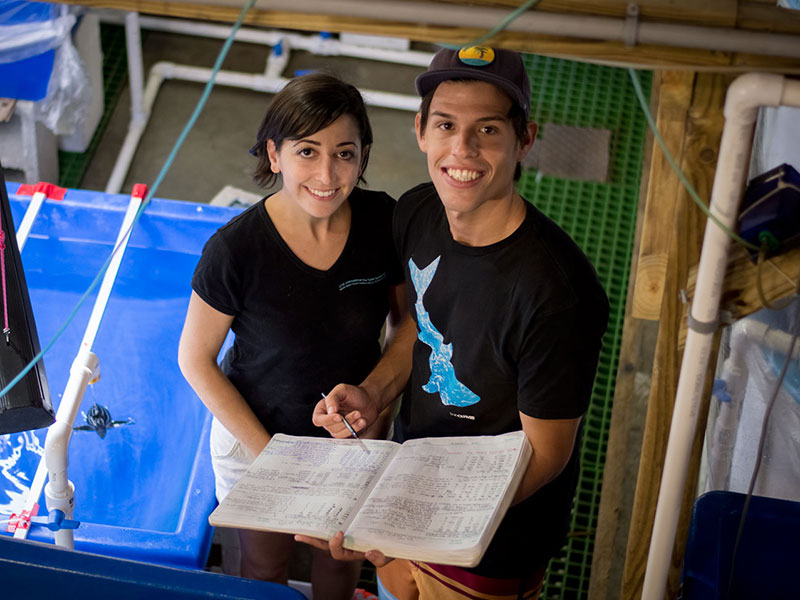FAU Students Educate the Community at Gumbo Limbo Environmental Complex
Integrative biology doctoral students Alexandra Lolavar and Boris Tezak are helping to educate our community and its visitors on sea turtle research and conservation efforts.

Alex Lolavar and Boris Tezak are helping to educate our community on sea turtle research and conservation efforts.
Integrative biology doctoral students Alexandra (Alex) Lolavar and Boris Tezak are helping to educate our community and its visitors on sea turtle research and conservation efforts – and much more. The two, with a combined nine years of experience working with turtles, spend almost every day in the FAU Marine Research Building at Gumbo Limbo Environmental Complexin Boca Raton, home of on an ongoing sea turtle study led by Jeanette Wyneken, Ph.D., professor of biological sciences in FAU’s Charles E. Schmidt College of Science.
Wyneken’s study, which began in 2002, focuses on the sex ratios of sea turtles that hatch along Boca Raton’s beaches, and specifically how the temperature and moisture of the sand affect those ratios. The belief is that cooler sand produces more males and warmer sand produces more females; in fact, 95 percent of the approximately 4,000 hatchlings studied at Gumbo Limbo have been female. Three species have been studied: 55 percent have been loggerheads, 40 percent have been greens, and 5 percent have been leatherbacks.
In the summer and fall, visitors to Gumbo Limbo can get a bird’s eye view of the important research taking place. Sea turtle hatchlings can be viewed from the upper-level visitors’ gallery, where Boris and Alex often are stationed to answer questions about the turtles, their research and the studies of other FAU scientists at the lab. They also are happy to talk with visitors in the gallery when they’re working in the lab below.
“I hope that the visitors I speak with gain a better understanding of the importance of our research,” said Alex. “Studying the turtles helps us work toward the conservation and protection of these threatened and endangered species.”
During each nesting season beginning in March, Alex and Boris assist with selecting 10 to 12 nests for the study. Each nest is fitted with a temperature tracking device that records temperatures throughout the 45- to 60-day incubation period. When the eggs hatch, Alex and Boris assist with collecting several of the approximately 100 hatchlings from each nest for the study.
The turtles are raised in the lab until they are approximately three months old. During this time, Alex and Boris help care for the turtles and record data for each one, including how much they eat; their weight, length and width; and any unusual behavior. After three months, a non-harmful procedure is performed to check the turtles’ reproductive organs. Soon after the sex of each is identified, they get a lift offshore where they are released.
“It’s great to see visitors get excited about the research we’re doing,” said Boris. “It’s also a great opportunity to remind them of simple ways to help the conservation effort, such as dimming lights near the beach and keeping garbage – especially plastic – out of our oceans.”
When they’re not in the lab or gallery, Alex and Boris teach undergraduate classes and are active members of FAU’s Association of Biological and Biomedical Students; Boris is vice president. They both plan to continue doing research after they graduate. Alex might like to work for a government organization, while Boris would like to do post-doctoral work in Australia and then teach at a university.
For more information about Gumbo Limbo, visit www.gumbolimbo.org.
-FAU-
Tags: research | science | students | graduate college